Honor Award
Potential Applications of the Vetiver System in the Lake Amatitlan Watershed, Guatemala
I Maria Calderon, Student ASLA, Undergraduate, Cornell University
Faculty Advisors: Peter Trowbridge, FASLA, Jamie Vanucchi and Nina Bassuk
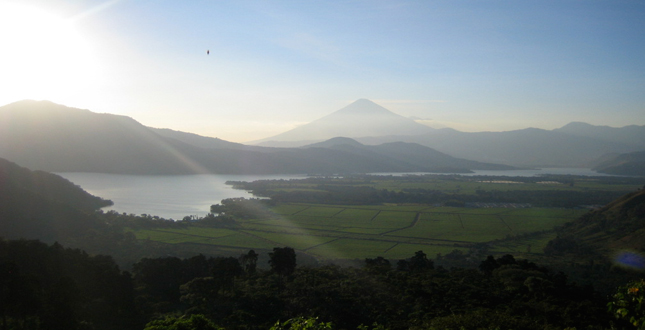 Close Me!
Close Me!Lake Amatitlan Surrounded by farmland
Download Hi-Res ImageImage: I Maria Calderon and Paul Truong
Image 1 of 13
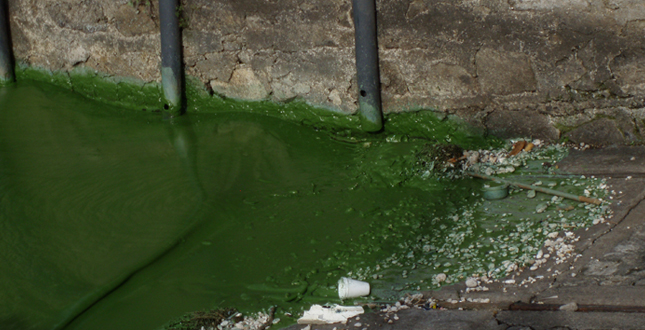 Close Me!
Close Me!Microcystin Bacteria thrives in the lake, causing eutrophication
Download Hi-Res ImageImage: I Maria Calderon and Paul Truong
Image 2 of 13
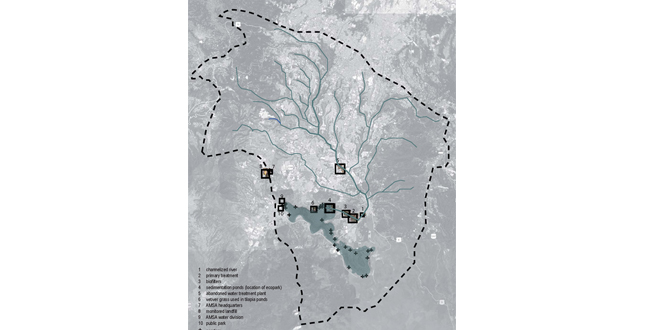 Close Me!
Close Me!Lake Amatitlan Watershed and AMSA iniciatives
Download Hi-Res ImageImage: I Maria Calderon and Paul Truong
Image 3 of 13
 Close Me!
Close Me!Vetiver Grass in the foreground demonstrates its “broken tip” characteristic which can help identify this tropical plant. The pontoons in the ponds are floating rafts with vetiver planted in a mesh and the sealed PVC pipes help them float.
Download Hi-Res ImageImage: I Maria Calderon and Paul Truong
Image 4 of 13
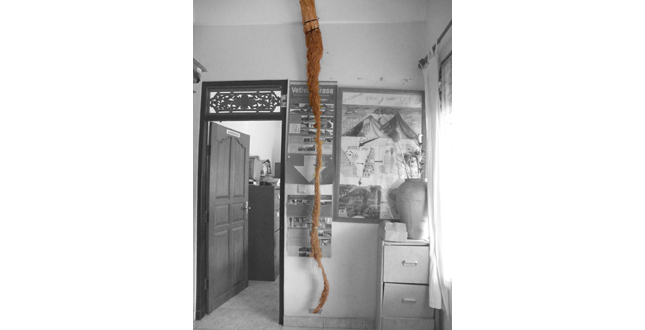 Close Me!
Close Me!Vetiver roots can grow 3.6 meters in just one year. These dug out roots are hung in reception hall of the East Bali Poverty Project NGO in Indonesia.
Download Hi-Res ImageImage: I Maria Calderon and Paul Truong
Image 5 of 13
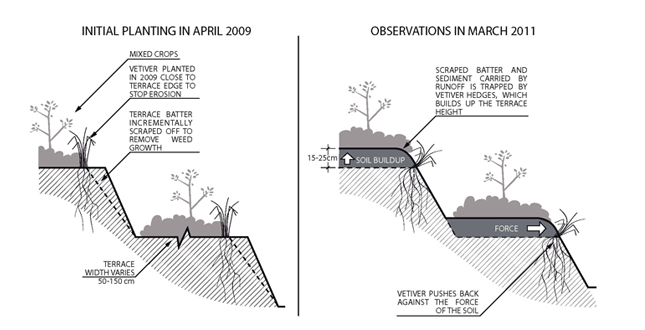 Close Me!
Close Me!Vetiver hedges planted on terrace edges will hold back sediment carried from upland by runoff and increase agricultural productivity.
Download Hi-Res ImageImage: I Maria Calderon and Paul Truong
Image 6 of 13
 Close Me!
Close Me!Preparing the terrain for planting vetiver slips in a flash flood control site.
Download Hi-Res ImageImage: I Maria Calderon and Paul Truong
Image 7 of 13
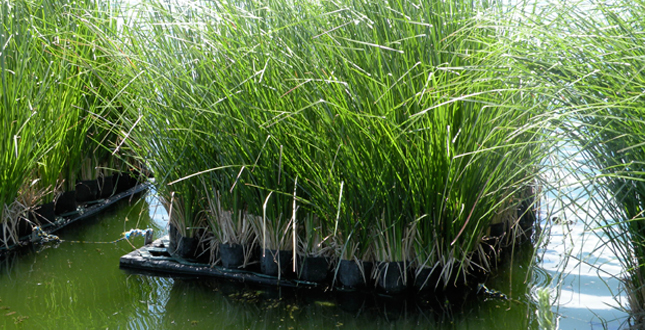 Close Me!
Close Me!Vetiver Pondoons at fertilizer company in Brisbane, Australia planted in pots inside of mesh. Roots have direct access to fertilizer in effluent, helping achieve the polishing level needed to meet the EPA standards.
Download Hi-Res ImageImage: I Maria Calderon and Paul Truong
Image 8 of 13
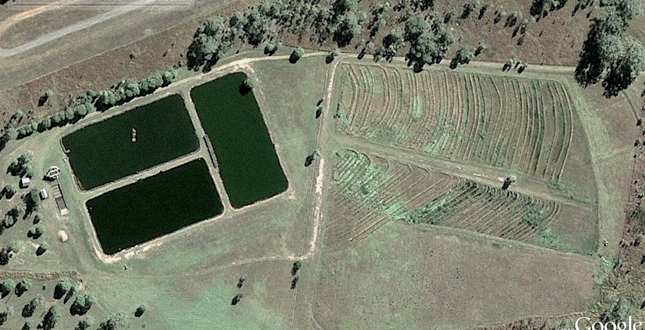 Close Me!
Close Me!This horizontal-flow wetland in Toogooloowah, Australia has Vetiver planted along the slope contours which helps back up effluent behind the Vetiver rows which then soak it up. Satellite image courtesy of Google Earth.
Download Hi-Res ImageImage: I Maria Calderon and Paul Truong
Image 9 of 13
 Close Me!
Close Me!Swale at Springfield Lake, Brisbane after the January floods flattened the typha to the ground and left the Vetiver plants erect.
Download Hi-Res ImageImage: I Maria Calderon and Paul Truong
Image 10 of 13
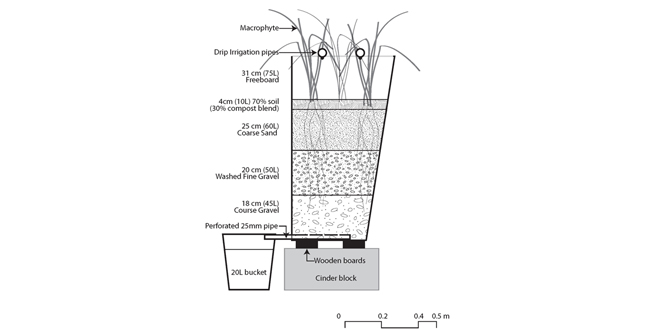 Close Me!
Close Me!Pilot size constructed wetland in 240 L wheelie bin set up at the Loganholme Water Treatment Plant. The trial included 56 wheelie bins with 6 species (+old Vetiver), 1 control X4 replicates and 1 trial X 4 replicates.
Download Hi-Res ImageImage: I Maria Calderon and Paul Truong
Image 11 of 13
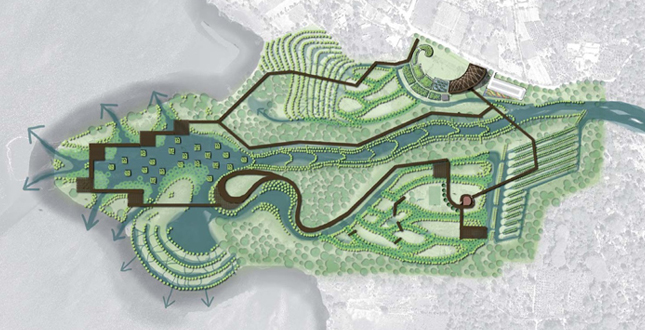 Close Me!
Close Me!Constructed Wetland Park welcomes visitors to learn about Vetiver applications and how it helps clean up polluted water.
Download Hi-Res ImageImage: I Maria Calderon and Paul Truong
Image 12 of 13
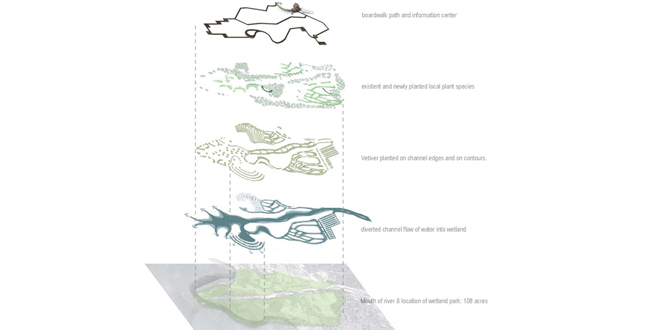 Close Me!
Close Me!Exploded axonometric of the constructed wetland park.
Download Hi-Res ImageImage: I Maria Calderon and Paul Truong
Image 13 of 13
Project Statement
This research focuses on the possible hydrological, infrastructural and social applications of the Vetiver System - an affordable bioengineering technology – in the watershed of a highly polluted lake near Guatemala City, and how the construction of a wetland park displaying the different uses of Vetiver Grass could teach people how to participate in a movement to clean the lake. Interviews, research and data collection were conducted in Guatemala, Chile, Australia and Indonesia.
Project Narrative
—2011 Student Awards Jury
Problem Researched
Lake Amatitlan, a 15km2 body of water near Guatemala City, is the most polluted natural resource of its kind in Central America, receiving its water from a largely urbanized watershed extending 381 Km2. Its main influent, the Villalobos River, deposits about 500,000 tons of sediment caused by erosion in gullies every year into the lake causing it to slowly loose its depth, while the daily inflow of 437,500 m3 liters of water contaminated by industrial waste, fertilizers and untreated sewage has triggered the proliferation of a green microcystin algae that is inhospitable to humans and the ecology of the lake. Although there have been efforts by a government agency to help clean the lake, their "end of pipe solutions" have been addressing issues at the end of the river and within the lake, and lack of funding has prevented them from pushing their pilot projects and awareness campaigns through.
Objective
The lack of funding and little knowledge of affordable green technologies prevents the local government administration from making meaningful changes in the population's attitude towards the lake. By providing feasible examples displayed in a public park for how to reduce their impact within the watershed, people will begin to collaborate in a green movement that will restore Lake Amatitlan to make it once again a culturally valuable natural resource. The controlled use of a non-invasive but extremely hardy wetland grass called Chrysopogon zizanioides, or Vetiver, can be the solution to many of the erosion and water pollution problems that are currently affecting the lake. This research focuses on some of the applications of Vetiver Grass which can be applied in this watershed.
Relationships Investigated and Method of Inquiry Used
- Current practices used to clean up the Lake Amatitlan Watershed. Method: Interviewing and visiting projects built by the Administration for the Sustainable Management of Lake Amatitlan and its watershed (AMSA) in Guatemala.
- Evaluating the progress and effectiveness of sites around the world that use the Vetiver System for Water Treatment, Slope Stabilization, and low income applications that can be applied in the Lake Amatitlan watershed. Method: Travels funded by the Dreer Travel Award from the Cornell University Horticulture Department and research funded by the Australian companies Gelita Pty. Ltd, Veticon Consulting, and the Organic Force.
- Using research on the Vetiver System to inform the design of a constructed wetland park meant for the people living on the watershed which can be used to teach locals and government agencies about the different methods for applying the Vetiver System in their own homes, industries and agricultural sites.
Results of Research, Conclusions Concerning the Significance of the Results and Comparisons with Past Research
The current AMSA administration programs includes educators, engineers, biologists, chemists, aquaculturalitsts and more than 120 people who have been by hired to try to improve the health of the lake and create awareness about the destruction occurring throughout the watershed. However, over the past seven years of operation, a lot of the effort that AMSA has put in has had dwindling results. Graphs of the water quality in the Villalobos river showed an increase in the chemical oxygen demands (an indicator of the amount of bacteria in water) raising from 40 mg/L in 2005, to 98 mg/L in 2007. Only one of three waste water treatment plants constructed to treat the water in the river is still operating today, while the rest proved to be ineffective, abandoned, destroyed, and unheard of by most people. In 2008, a sedimentation pond was built in order to absorb some of the sediments coming out from the river and later be dredged. However, in 2010, it was destroyed during a flood, and sediments have since continued to fill in the lake. A series of energy intensive aerators scattered throughout the lake have replenished some of the stagnant flow within the lake but are hard to give maintenance to and have had parts stolen. Many of the projects that AMSA has taken on have been only partially successful, mainly because people in the watershed do not have a sense of responsibility towards taking care of the lake, because they do not value it for the wonderful resource it has the potential to be.
An affordable green technology which can be implemented throughout the watershed to compliment the works that AMSA has carried out, is the Vetiver System, which uses a grass ranging 0.5 - 4.0 meters tall called Chrysopogon zizanioides (Vetiver) for green infrastructure projects in the tropics and subtropics. I went to research more about the Vetiver System in Australia and Indonesia, focusing on its uses for wastewater polishing and slope stabilization. In civil works, its cost is about 1/20th the cost of the traditional grey infrastructure. This sterile and therefore non-invasive plant originated in Southern India and was propagated for the extraction of essential oils from its dense root system, which can grow up to 3.6 m deep in a year. These roots have been called "A Living Soil Nail" thanks to their average tensile strength of 1/6 of mild steel. Additionally, this plant is being used to extract nutrients from wastewater and can tolerate high concentrations of heavy metals; acidic, alkaline, or saline soils, Herbicides, plagues, complete saturation or drought and even fires. Fortunately, it is a great pioneer species and its intolerance to shade will allow other plants to colonize after it has established the appropriate soil structure for their survival.
Vetiver Hedges for Slope stabilization and Flash Flood Control is now a well understood technique being used in Australia and around the world. Vetiver hedges planted on the contours and with vertical intervals of 0.5-1.5 meters can serve as a barrier to hold back fine sediments that can improve the vitality of barren slopes or agricultural fields. With funds from the Dreer Research Award, I got to visit many existing Vetiver projects in Brisbane and Bali to verify their long term resilience based on the conversations and photographs taken by the director of the Vetiver Network International for Asia and the Pacific, Paul Truong. This archival of information was summarized and written in monthly reports that were sent out to the entire Landscape Architecture and Horticulture Department at Cornell University. Additionally, I received hands-on training on how to propagate the plant, separate its shoots, prepare the terrain and plant it. The main goal for bringing the techniques of the Vetiver System to Guatemala is as a means to stabilize the extremely erodable and precarious gullies in the watershed of Lake Amatitlan that end up depositing tons of sediments into the river and destroying the Lake's ecosystem.
Constructed wetlands using the Vetiver system have proven to be successful in Australia in removing nutrients from water (Truong et al. 50) and are being used for treating different components of wastewater. Some of the applications in constructed wetlands in Brisbane included floating pontoons at a fertilizer and explosives factory, a subsurface flow wetland with Vetiver planted on contours in order to absorb secondary treated wastewater stored in ponds , bioswales at a housing development for beatification as well as transporting and filtering stormwater, and channels plated with Vetiver on contours for flood and erosion control.
During my time in Australia, I was involved in a research project on aiding in the humification and breakdown of septic sludge, an inevitable solid/humid byproduct of wastewater which needs to be composted, and helped an organic composting company construct a series of 56 small scale Macrophyte (reeds and tall grasses) Sludge Drying Beds (MSDB) built inside wheelie bins with an outlet pipe in the bottom. The goal of the experiment was to understand which of the six species tested would best survive the rising sludge levels (figure 12). Due to time limitations and because the plants were still in the establishment phase, I was only involved in the construction and in monitoring the growth of the plants (no conclusive data has been obtained yet). So far, no research has been done using Vetiver in MSDB, and the results of this trial will help understand whether the Vetiver root structure would help create useful compost and dry up the sludge in the quickest amount of time. Such knowledge would be extremely valuable in Guatemala because many households choose no to deal with septic tanks due to maintenance issues and difficulty of getting pumping services, and consequently many end up depositing their wastewater untreated into the rivers.
Applicability to Landscape Architecture Practice
By combining the information learned about the Vetiver System and other bioengineering techniques with my studies in Landscape architecture, I designed a constructed wetland ecopark that would divert about a third of the water, or 145,800 m3, from the Villalobos River to polish the nutrient and heavy metal loads that might be in the water while at the same time trap many of the sediments that would otherwise get deposited into the lake. Although such a park would only take care of part of the flow from the river, the remaining water would not get filtered unless more constructed wetlands are built or this one is expanded. Therefore, in order to start a green movement that will get people excited about having a cleaner more useful lake, would be to have the park serve as an educational venue for people from the watershed to come to the visitor centre, where information about the Vetiver System and other Best Management Practices would be disseminated. For example, people living illegally in the gullies throughout the watershed could plant Vetiver on the banks of the river and use that green infrastructure for the dual purpose of stabilization and, if they have a septic tank, divert it into the vetiver hedges so that they absorb the nutrients in the effluent. Various programming aspects of the ecopark relating to Vetiver would be used in the park and access would be provided to them through the boardwalk circulating the constructed wetland. Rest spots and information boards would be spread throughout the boardwalk and would reveal the various Vetiver applications they can include in their homes, industries, or agriculture sites.
The Need for New or Further Research
Before constructing the wetland park mentioned above, it would be imperative to figure out the social implications behind starting a Green Movement Against Green Water — how interested are people in taking part in it? How well do people grasp and make use of the Vetiver System. This could be done by interviewing people of different backgrounds living in the watershed, asking them how often they go to the lake, their reasoning behind this, how interested they would be in helping clean up the lake once they learn the implications behind it and the type of things they can do to help.
Additional research is need on figuring out the cheapest way to build a small scale biological treatment plant for industries, condominiums or groups households that would take care of the waste on site and in a way that people don't feel burdened by the amount of maintenance needed. The goal would be to design the biological treatment plant in such a way that people feel like it is an asset to their house, where they can use the Vetiver foliage for handicrafts, mulch, thatching, or forage. Additionally, more information is needed on how to effectively compost the humified sludge from the MSDB and on whether it would be fit for use in enhancing crop growth or gardening.
Other Significant Issues
Unfortunately, several lakes in Guatemala as well as in other tropical third world countries are suffering the same fate. Succeeding in cleaning up Lake Amatitlan, would be a tremendous achievement, as it is one of the most contaminated lakes in South America and could serve as a pilot wetland to other third world countries in need of simple bioengineering solutions.
References
Butler, Amanda. Batch Sequence Reed Bed Project for the Treatment of Industrial Effluent. GELITA, 2006. Print.
Calderon, Maria. Green Movement Against Green Water — Cornell University Landscape Architecture Honors Thesis. May 2010. http://hdl.handle.net/1813/17514
Guatevision — los secretos major guatrdados del agatha. September 2010. http://www.rescatemosnuestrolago.blogspot.com/
Reyna , Evelyn Irene. Integrated Management of the Lake Amatitlan Basin. The World Bank/WBI's CBNRM Initiative. February1998. http://srdis.ciesin.columbia.edu/cases/guatemala-004-en.html
Samayoa, Ana Cristina and Lee, Chong Ging. La Cuenca y el Lago de Amatitlan, Nivel Superior. AMSA, Guatemala. 2002
Truong, Paul, Tran Tan Van, and Elise Pinners. Vetiver System Applications — A Technical Manual. Second. 2006. Print.
Additional Project Credits
Cornell Horticulture Department
Frederick Dreer Travel Award Committee:
Nina Bassuk, Jeremy Foster, Marvin Pritts
Cornell Landscape Architecture Department:
Thesis Advisors: Jamie Vanucchi, Peter Trowbridge, FASLA
Veticon Consulting, Brisbane, Australia Paul Truong
East Bali Poverty Project, Bali, Indonesia David J. Booth
First Latin American Conference on Vetiver, Santiago, Chile
The Organic Force, Brisbane, Australia
Johannes Biala






